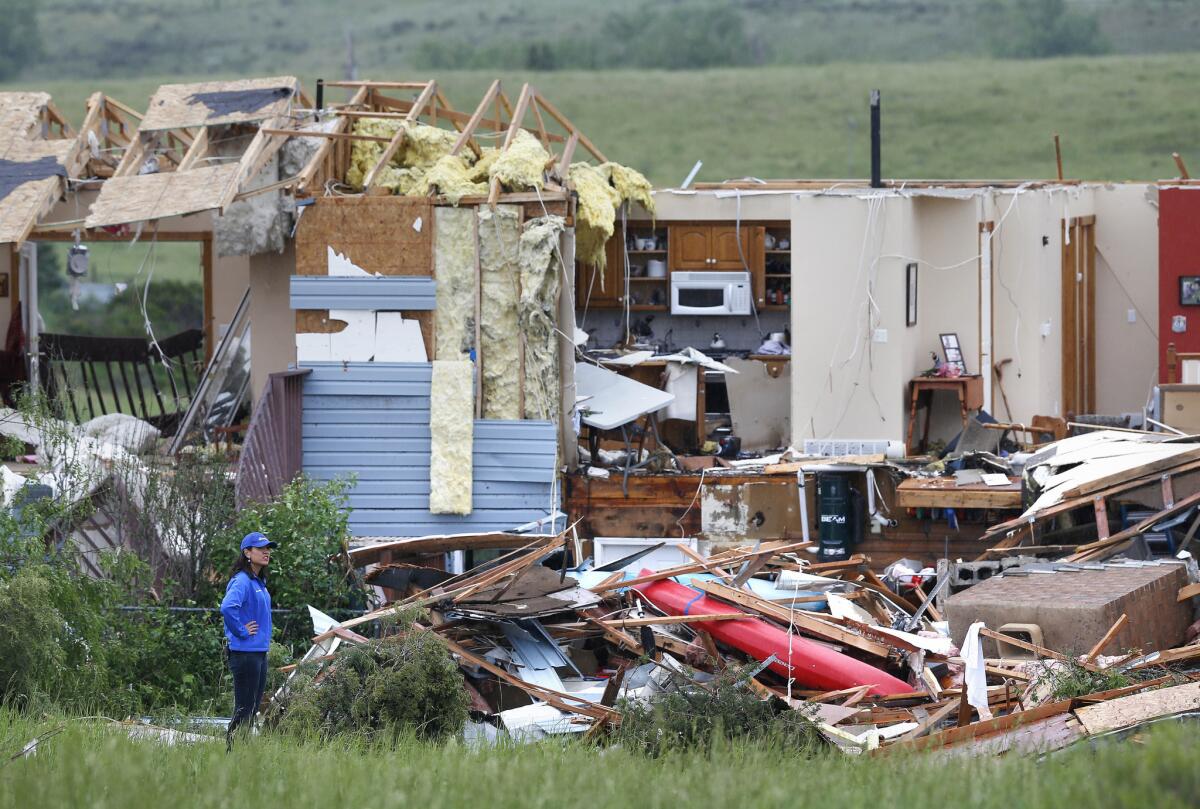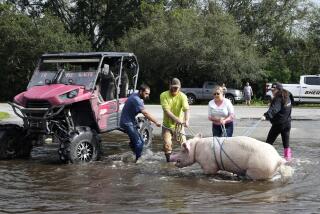Colorado residents survey damage from hail and tornadoes, brace for more storms

A woman surveys the damage around a home gutted by a tornado that struck Thursday near the town of Berthoud, Colo.
- Share via
Reporting from Berthoud, Colo. — Joe Garguilo emerged sleepy-eyed from his house Saturday after enduring another night of pounding rain and wind, coming on the heels of a tornado that had ripped through his property a few days earlier.
“See that horse trough by the van?” he asked, pointing to the end of his driveway. “I don’t own a horse; my neighbors don’t own a horse. So how did it get there?”
He bent down and picked up a lone cowboy boot.
“Whose boot is this?” he asked. “Who knows? I don’t know. Nobody knows.”
That’s an increasingly common sentiment in Colorado, where residents have been baffled by a bizarre mix of weather featuring destructive hailstorms, nearly a dozen tornadoes, flash floods and lightning illuminating the night skies.
In May, almost daily rain made a mockery of Colorado’s unofficial slogan touting its “300 days of sunshine” per year. Local news programs even offered segments on SAD, or seasonal affective disorder, to help residents fight off the gloom.
But while the daily rain has mostly retreated, huge storms have moved in.
The city of Denver on Friday dispatched snowplows to remove 4 feet of golf-ball-sized hail that nearly buried one Westside neighborhood. The day before, tornadoes demolished three homes and damaged more than a dozen others in Boulder and Larimer counties. Five more were mangled in Simla on the Eastern Plains. Meanwhile, swollen rivers threatened to overflow their banks.
National Weather Service forecasters say the mayhem has been caused by an intersection of hot weather and low-level moisture. They predicted more storms this weekend.
Perhaps no place has been hit as hard as rural Berthoud, about 50 miles north of Denver, where a tornado struck Thursday night.
Garguilo, 62, who has lived here since 1978, was in the basement watching “The Departed” when he heard a noise.
“I go upstairs and all of a sudden my ears pop, and then ‘whoosh,’” said the Brooklyn native, a retired entrepreneur. “I don’t want to say it sounded like a freight train, but it sounded like a freight train.”
His windows imploded, allowing driving hail to pelt his water bed, setting up what he described as “a very messy situation.” He shoved the bed out of harm’s way. The shower backed up with sewage.
“I thought the roof was going to cave in,” Garguilo recalled, walking around his shattered backyard. “The hail sounded like metal hitting metal.”
When he finally got outside, he found his beloved satellite dish crumpled, his fences ripped off and his swimming pool choked with fence parts. A sheet of metal, sharp as a buzz saw, had flown in from somewhere and wrapped around an aspen tree.
“Of course it didn’t hit the dead aspen,” he said.
A broken limb impaled his roof and a 4-by-8 sheet of plywood perched atop his towering blue spruce tree.
“I built my own little Xanadu here. I smoke my cigars, watch my movies; I have good liquor,” he said. “But I never saw anything like this — nothing even in the ballpark like this.”
Garguilo was most stunned by a pair of glasses left outside that remained perfectly intact while everything nearby was ruined.
“What do they weigh, 2 ounces?” he asked. “I thought that was the coolest thing of all.”
Around the corner, the damage was worse. Homeowner Richard Scott, 75, watched the tornado heading straight for him. He made it into his son’s basement next door, with just seconds to spare.
“I was being peppered with debris as I tried to get to the house,” he said. “When I was in the basement the house just blew up around me. We still had the ceiling above us but everything else was gone.”
When the family emerged 45 minutes later, they found three metal storage containers about the size of tractor-trailers flipped upside down in a field. The house had its walls torn off, half of the garage was missing and a stately tree once festooned with swings lay uprooted.
“I wasn’t prepared for the destruction,” Scott said. His daughter Tammi stuck her head through the oval window in the front door. “There used to be glass in here,” she said.
The prized 1971 white pick-up truck belonging to his wife, Ty, lay in a grassy field 100 yards from where it once sat. Bits and pieces of it — a battery here, a broken headlight there — were strewn like bread crumbs marking the route.
“That was my joy,” she said as she walked toward the crushed truck. “My joy.”
She brightened a bit after finding something in the tall grass.
“Look at that,” she exclaimed. “I still have my shovel!”
Other homes on the road were destroyed. Some were missing roofs, doors and windows.
“It’s all just stuff,” Richard Scott said. “Everyone is alive. That’s all that matters.”
Farther south near Lyons, almost destroyed during the floods of 2013, Molly Hardman, 60, welcomed a new addition she’d had delivered to her yard Friday night — a bright-green portable toilet.
Torrential hail had destroyed the family’s septic system.
“When I get up to take the dog out, I go out as well,” she said.
The hail wiped out her vegetable garden, with some plants looking like they had sustained shotgun wounds. A fish pond had been nearly buried by a rock slide and their cars were pock-marked by hail.
“It was deadly to go out there,” said Hardman’s husband, Gordon, 64.
As an aerospace engineer, Molly Hardman works on climate-change issues and is convinced this kind of weather is a direct result of that phenomenon.
“It just reinforces what I know about climate change and the impact it’s having on our planet,” she said. “I think we are going to see a lot more of this.”
David Kelly is a special correspondent.
For national news follow @latimesnational.
More to Read
Sign up for Essential California
The most important California stories and recommendations in your inbox every morning.
You may occasionally receive promotional content from the Los Angeles Times.










